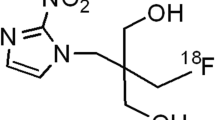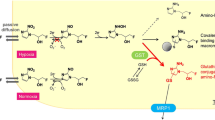Abstract
Objective
In this study, we designed and synthesized four novel 68Ga-radiolabeled compounds ([68Ga]DN-3, [68Ga]DN-4, [68Ga]NN-3, and [68Ga]NN-4) composed of a nitroimidazole and two types of bifunctional chelates (DOTA or NOTA) via several alkyl linkers of different length. Then, we evaluated their properties as hypoxia imaging probes for positron emission tomography (PET) compared with conventional compounds ([68Ga]DN-2 and [68Ga]NN-2).
Methods
The precursors of 68Ga-radiolabeled compounds were synthesized through a two-step reaction, and then reacted with 68GaCl3 to be 68Ga-radiolabeled compounds. FaDu cells were treated with 68Ga-radiolabeled compounds and then incubated under normoxic (21% O2) or hypoxic (1% O2) conditions. The radioactivity of these cells was measured 2 h after incubation. The biodistribution and PET/CT imaging of 68Ga-radiolabeled compounds in FaDu-bearing Balb/c nude mice were evaluated 2 h after intravenous injection.
Results
The 68Ga-radiolabeled compounds were synthesized with radiochemical purities over 95%. In the in vitro study, the levels of 68Ga-radiolabeled compounds were significantly higher in hypoxic cells than in normoxic cells. In hypoxic cells, the compounds we designed in this study demonstrated higher accumulation than the conventional compounds. In the in vivo biodistribution study, [68Ga]DN-3 exhibited the highest accumulation in tumor. In the in vivo PET/CT imaging study, the tumor tissues of the FaDu-xenografted mice were visualized at 2 h after intravenous administration of 68Ga-radiolabeled compounds.
Conclusions
Our study suggested that the length of the linkers connecting nitroimidazole to a bifunctional chelate affect PET imaging of hypoxic tumors with 68Ga-radiolabeled compounds.





Similar content being viewed by others
References
Bertout JA, Patel SA, Simon MC. The impact of O2 availability on human cancer. Nat Rev Cancer. 2008;8:967–75.
Horsman MR, Mortensen LS, Petersen JB, Busk M, Overgaard J. Imaging hypoxia to improve radiotherapy outcome. Nat Rev Clin Oncol. 2012;9:674–87.
Tewson TJ. Synthesis of [18F]fluoroetanidazole: a potential new tracer for imaging hypoxia. Nucl Med Biol. 1997;24:755–60.
Riché F, d’Hardemare AD, Sèpe S, Riou L, Fagret D, Vidal M. Nitroimidazoles and hypoxia imaging: synthesis of three technetium-99m complexes bearing a nitroimidazole group: biological results. Bioorg Med Chem Lett. 2001;11:71–4.
Kumar P, Naimi E, McEwan AJ, Wiebe LI. Synthesis, radiofluorination, and hypoxia-selective studies of FRAZ: a configurational and positional analogue of the clinical hypoxia marker, [18F]-FAZA. Bioorg Med Chem. 2010;18:2255–64.
Wilson WR, Hay MP. Targeting hypoxia in cancer therapy. Nat Rev Cancer. 2011;11:393–410.
Masaki Y, Shimizu Y, Yoshioka T, Feng F, Zhao S, Higashino K, et al. Imaging mass spectrometry revealed the accumulation characteristics of the 2-nitroimidazole-based agent “pimonidazole” in hypoxia. PLoS ONE. 2016;11:e0161639.
Masaki Y, Shimizu Y, Yoshioka T, Tanaka Y, Nishijima K, Zhao S, et al. The accumulation mechanism of the hypoxia imaging probe “FMISO” by imaging mass spectrometry: possible involvement of low-molecular metabolites. Sci Rep. 2015;5:16802.
Shimizu Y. Accumulation mechanism of 2-nitroimidazole-based hypoxia imaging probes revealed by imaging mass spectrometry. Yakugaku Zasshi. 2018;138:1345–52.
Shimizu Y, Zhao S, Yasui H, Nishijima KI, Matsumoto H, Shiga T, et al. A novel PET probe “[(18)F]DiFA” accumulates in hypoxic region via glutathione conjugation following reductive metabolism. Mol Imaging Biol. 2019;21:122–9.
Troost EG, Laverman P, Philippens ME, Lok J, van der Kogel AJ, Oyen WJ, et al. Correlation of [18F]FMISO autoradiography and pimonidazole [corrected] immunohistochemistry in human head and neck carcinoma xenografts. Eur J Nucl Med Mol Imaging. 2008;35:1803–11.
Toyonaga T, Hirata K, Shiga T, Nagara T. Players of ’hypoxia orchestra’—what is the role of FMISO? Eur J Nucl Med Mol Imaging. 2017;44:1679–81.
Piert M, Machulla HJ, Picchio M, Reischl G, Ziegler S, Kumar P, et al. Hypoxia-specific tumor imaging with 18F-fluoroazomycin arabinoside. J Nucl Med. 2005;46:106–13.
Brandt M, Cardinale J, Aulsebrook ML, Gasser G, Mindt TL. An overview of PET radiochemistry, part 2: radiometals. J Nucl Med. 2018;59:1500–6.
Zhernosekov KP, Filosofov DV, Baum RP, Aschoff P, Bihl H, Razbash AA, et al. Processing of generator-produced 68Ga for medical application. J Nucl Med. 2007;48:1741–8.
Roesch F, Riss PJ. The renaissance of the 68Ge/68Ga radionuclide generator initiates new developments in 68Ga radiopharmaceutical chemistry. Curr Top Med Chem. 2010;10:1633–68.
Hoigebazar L, Jeong JM, Hong MK, Kim YJ, Lee JY, Shetty D, et al. Synthesis of 68Ga-labeled DOTA-nitroimidazole derivatives and their feasibilities as hypoxia imaging PET tracers. Bioorg Med Chem. 2011;19:2176–81.
Hoigebazar L, Jeong JM, Choi SY, Choi JY, Shetty D, Lee YS, et al. Synthesis and characterization of nitroimidazole derivatives for 68Ga-labeling and testing in tumor xenografted mice. J Med Chem. 2010;53:6378–85.
Wu Y, Hao G, Ramezani S, Saha D, Zhao D, Sun X, et al. [(68) Ga]-HP-DO3A-nitroimidazole: a promising agent for PET detection of tumor hypoxia. Contrast Media Mol Imaging. 2015;10:465–72.
Acknowledgements
This study was supported by grants from Takeda Science Foundation and the Research Foundation for Pharmaceutical Sciences.
Funding
This study is funded by Takeda Science Foundation and Research Foundation for Pharmaceutical Sciences.
Author information
Authors and Affiliations
Corresponding author
Additional information
Publisher's Note
Springer Nature remains neutral with regard to jurisdictional claims in published maps and institutional affiliations.
Electronic supplementary material
Below is the link to the electronic supplementary material.
Rights and permissions
About this article
Cite this article
Shimizu, Y., Nakai, Y., Iikuni, S. et al. Synthesis and evaluation of gallium-68-labeled nitroimidazole-based imaging probes for PET diagnosis of tumor hypoxia. Ann Nucl Med 35, 360–369 (2021). https://doi.org/10.1007/s12149-020-01573-5
Received:
Accepted:
Published:
Issue Date:
DOI: https://doi.org/10.1007/s12149-020-01573-5




